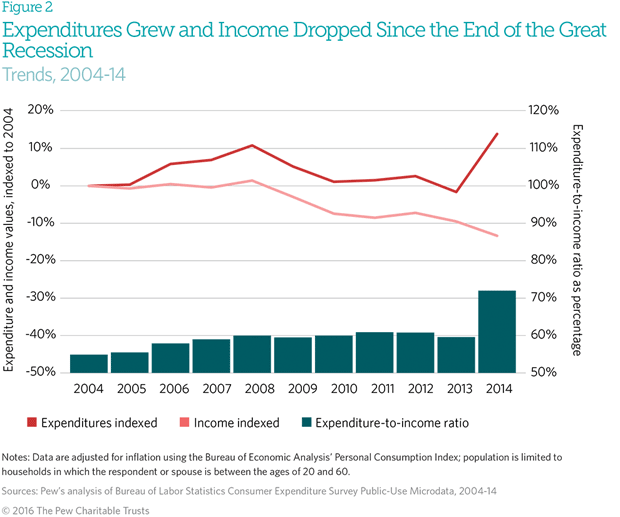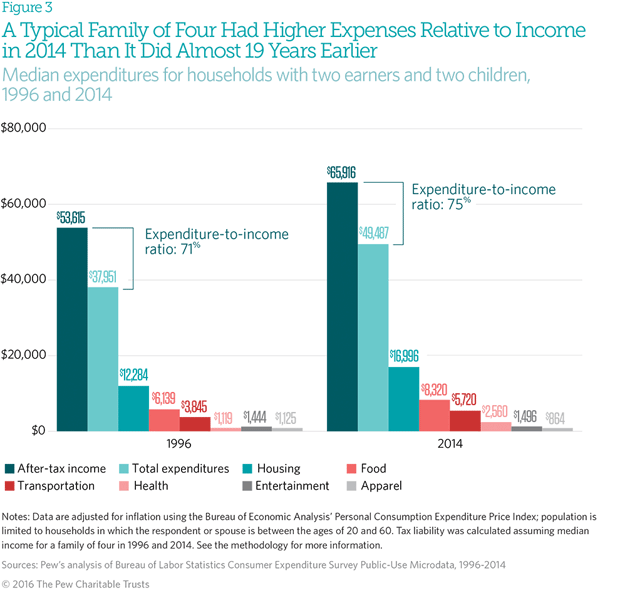The financial stranglehold on American families
Economic indicators such as the jobless rate point to a continuing recovery in America, but many families say they aren't feeling the benefit.
That struggle, it turns out, has very real roots, with new research from The Pew Charitable Trusts backing up the economic pain that Americans are feeling in their household accounts. While many economists look at income as an indicator of financial health, Pew took a different approach: what are Americans spending their money on, and how has that changed in the past two decades in relation to income?
It turns out that many households -- especially low-income and middle-income Americans -- are caught in a financial stranglehold. Expenses for essentials such as housing, food and transportation have surged during the past two decades, but income has failed to keep up. Low-income Americans are in especially dire shape, with the typical low-earner household now left with an annual financial hole of $2,300, meaning that their basics require them to outlay far more than their income can support.
The tough financial situation facing many households raises the question about whether they'll have a harder time achieving the American dream of financial security. It may also explain the challenges that many voters are expressing in this election, and points to why they feel the system is failing them.
"When you think about drivers of mobility and to create better or more efficient ladders, especially for families out of the bottom, then it's helpful to think about drivers of mobility and to think about financial security," Erin Currier, director of Pew's financial security and mobility project, said. "There is good data to suggest that families that have economic mobility are those with a cushion. You can't expect families to be economically mobile if they aren't first economically secure."
The bottom line: Overall median household expenditures grew by about 14 percent from 2004; income, however, has declined by 13 percent in the same period.
Low-income families have been hardest hit. Americans in the bottom third of income distribution are now spending 40 percent of their income on housing, while low-income renters are shelling out almost half of their pre-tax earnings on rent.
"Since the start of the housing crisis, homeownership rates declined in the middle and upper-income tiers," Currier said. "That really impacted the rental market. As former owners became renters, it led to historical lows in the vacancy rate, and that increases the cost of rental housing dramatically."
By comparison, Americans in the middle third of the income distribution are spending about 25 percent of their income on housing, while the top earners are spending about 17 percent of their earnings on their homes.
Like the pressures on renters, the overall trend toward higher expenses and lower income appears to be a defining characteristic of the current recovery. While Americans pared expenses during the Great Recession, they began spending more in 2012, although much of those expenses are tied to essentials, such as housing and food. Income, however, has continued to drop since 2012.
The country's stagnant wages have become a puzzle for economists and policy makers, with experts pointing to everything from the decline in American manufacturing to labor-market slack. Regardless of the cause, the hairpin trends of lower income and higher costs poses serious challenges for Americans.
"This is like a perfect storm for families," Currier said. "It's really a kitchen table issue, where they are feeling pinched and the data show clearly they don't have the savings and wealth to support themselves when financial emergencies happen. The desire for financial stability is very acute right now and the data shows that very clearly."
The amount of "slack" that families have in their budgets -- the money that's left over to spend on savings, education, life insurance and other wealth-building measures -- has shrunk since 2004, Pew found. The middle-third of Americans now only have $6,000 in slack, compared with $17,000 in 2004, the study found. For the lowest third, their slack has gone into the red, which means they may be relying on credit cards, loans, or friends to make up the difference.
"This underscores that low-income families have very little slack in investing in mobility, like savings or wealth building," Currier said.

